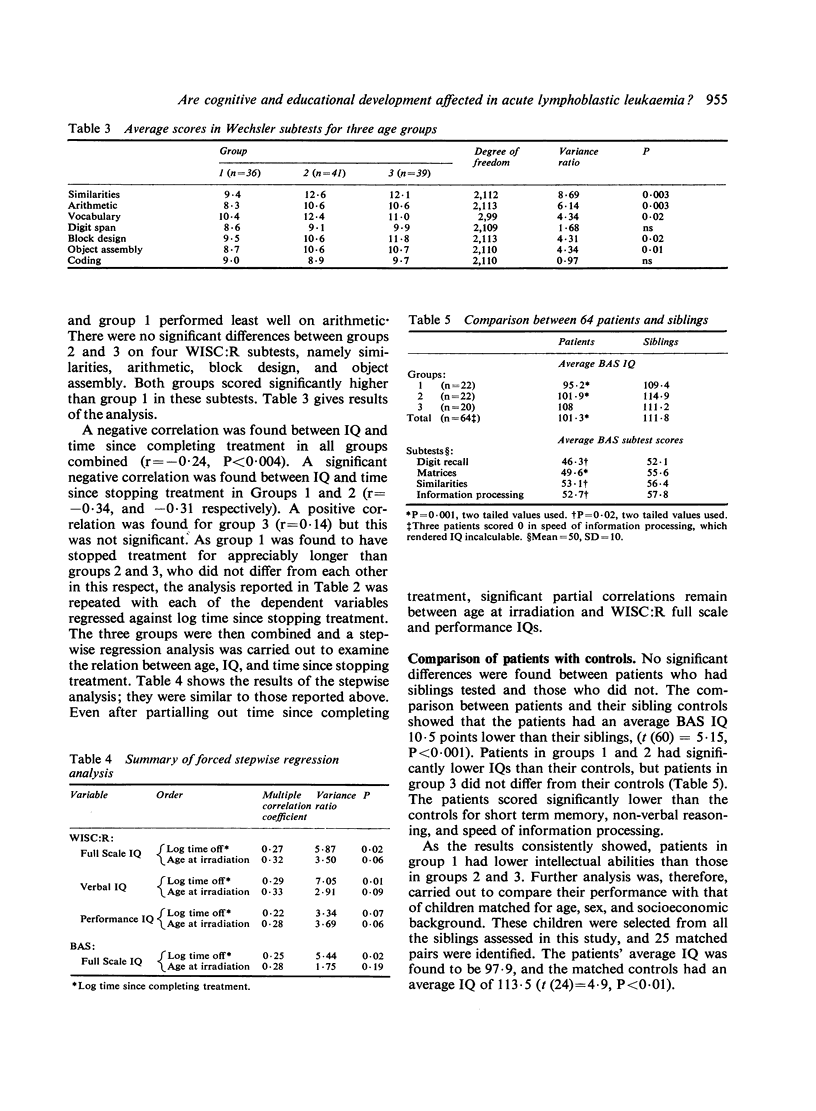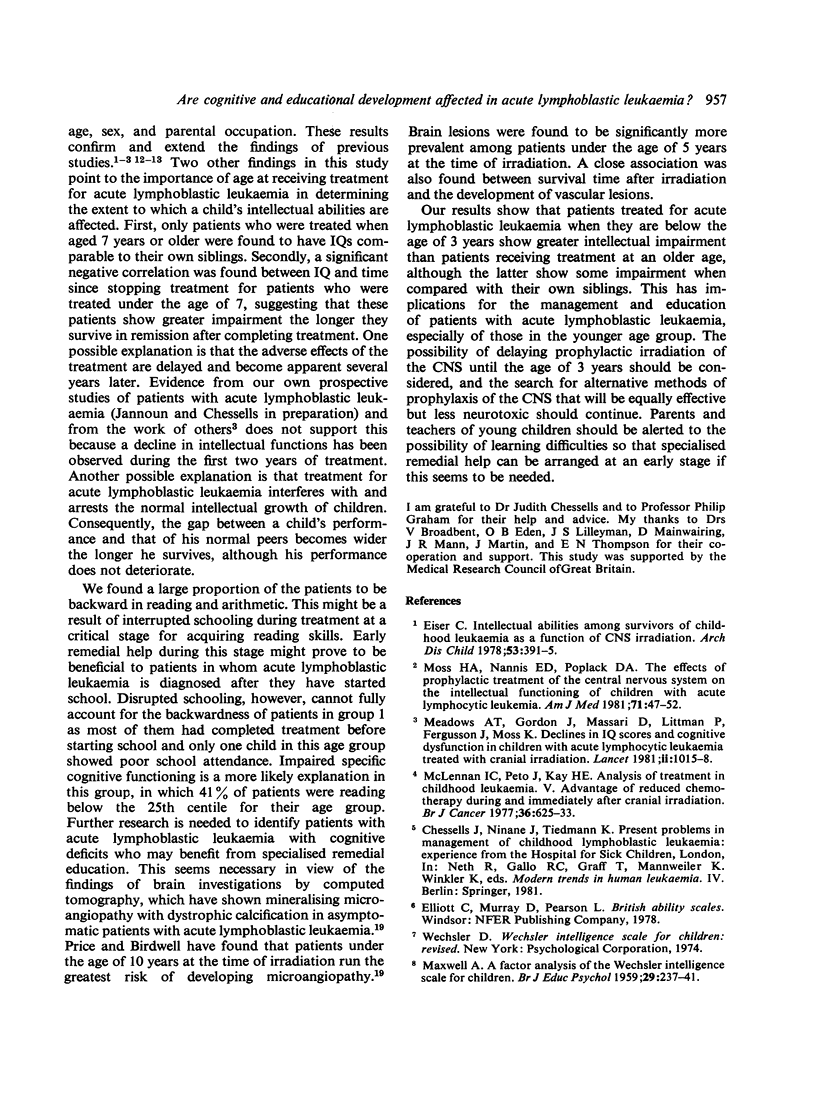Abstract
Altogether 129 children with acute lymphoblastic leukaemia in remission, all of whom had completed treatment, were assessed using standardised intelligence and attainment tests. A control group of 67 healthy siblings was also assessed. Results showed that the patients were functioning within the average range of intelligence several years after completing treatment but that they had significantly lower intelligence quotients (IQs) than their siblings. Only patients who received cranial irradiation when aged 7 years or more were no different in intelligence from their siblings. Patients who were treated under the age of 3 years were found to have significantly lower IQs than patients who received the same treatment at an older age and a group of healthy children matched for age, sex, and parental occupation. This finding has practical implications for the management and education of younger patients with acute lymphoblastic leukaemia.
Full text
PDF





Selected References
These references are in PubMed. This may not be the complete list of references from this article.
- Aur R. J., Simone J. V., Verzosa M. S., Hustu H. O., Barker L. F., Pinkel D. P., Rivera G., Dahl G. V., Wood A., Stagner S. Childhood acute lymphocytic leukemia: study VIII. Cancer. 1978 Nov;42(5):2123–2134. doi: 10.1002/1097-0142(197811)42:5<2123::aid-cncr2820420507>3.0.co;2-5. [DOI] [PubMed] [Google Scholar]
- Eiser C. Effects of chronic illness on intellectual development. A comparison of normal children with those treated for childhood leukaemia and solid tumours. Arch Dis Child. 1980 Oct;55(10):766–770. doi: 10.1136/adc.55.10.766. [DOI] [PMC free article] [PubMed] [Google Scholar]
- Eiser C. Intellectual abilities among survivors of childhood leukaemia as a function of CNS irradiation. Arch Dis Child. 1978 May;53(5):391–395. doi: 10.1136/adc.53.5.391. [DOI] [PMC free article] [PubMed] [Google Scholar]
- Eiser C., Lansdown R. Retrospective study of intellectual development in children treated for acute lymphoblastic leukaemia. Arch Dis Child. 1977 Jul;52(7):525–529. doi: 10.1136/adc.52.7.525. [DOI] [PMC free article] [PubMed] [Google Scholar]
- MacLennan I. C., Peto J., Kay H. E. Analysis of treatment of childhood leukaemia. V. Advantage of reduced chemotherapy during and immediately after cranial irradiation. Br J Cancer. 1977 Nov;36(5):625–633. doi: 10.1038/bjc.1977.240. [DOI] [PMC free article] [PubMed] [Google Scholar]
- McIntosh S., Klatskin E. H., O'Brien R. T., Aspnes G. T., Kammerer B. L., Snead C., Kalavsky S. M., Pearson H. A. Chronic neurologic disturbance in childhood leukemia. Cancer. 1976 Feb;37(2):853–857. doi: 10.1002/1097-0142(197602)37:2<853::aid-cncr2820370234>3.0.co;2-q. [DOI] [PubMed] [Google Scholar]
- Meadows A. T., Gordon J., Massari D. J., Littman P., Fergusson J., Moss K. Declines in IQ scores and cognitive dysfunctions in children with acute lymphocytic leukaemia treated with cranial irradiation. Lancet. 1981 Nov 7;2(8254):1015–1018. doi: 10.1016/s0140-6736(81)91216-2. [DOI] [PubMed] [Google Scholar]
- Moss H. A., Nannis E. D., Poplack D. G. The effects of prophylactic treatment of the central nervous system on the intellectual functioning of children with acute lymphocytic leukemia. Am J Med. 1981 Jul;71(1):47–52. doi: 10.1016/0002-9343(81)90257-6. [DOI] [PubMed] [Google Scholar]
- Nesbit M. E., Jr, Sather H. N., Robison L. L., Ortega J., Littman P. S., D'Angio G. J., Hammond G. D. Presymptomatic central nervous system therapy in previously untreated childhood acute lymphoblastic leukaemia: comparison of 1800 rad and 2400 rad. A report for Children's Cancer Study Group. Lancet. 1981 Feb 28;1(8218):461–466. doi: 10.1016/s0140-6736(81)91849-3. [DOI] [PubMed] [Google Scholar]
- Price R. A., Birdwell D. A. The central nervous system in childhood leukemia. III. Mineralizing microangiopathy and dystrophic calcification. Cancer. 1978 Aug;42(2):717–728. doi: 10.1002/1097-0142(197808)42:2<717::aid-cncr2820420244>3.0.co;2-3. [DOI] [PubMed] [Google Scholar]
- Price R. A., Jamieson P. A. The central nervous system in childhood leukemia. II. Subacute leukoencephalopathy. Cancer. 1975 Feb;35(2):306–318. doi: 10.1002/1097-0142(197502)35:2<306::aid-cncr2820350203>3.0.co;2-j. [DOI] [PubMed] [Google Scholar]
- Rutter M. A children's behaviour questionnaire for completion by teachers: preliminary findings. J Child Psychol Psychiatry. 1967 May;8(1):1–11. doi: 10.1111/j.1469-7610.1967.tb02175.x. [DOI] [PubMed] [Google Scholar]
- Sells C. J., Carpenter R. L., Ray C. G. Sequelae of central-nervous-system enterovirus infections. N Engl J Med. 1975 Jul 3;293(1):1–4. doi: 10.1056/NEJM197507032930101. [DOI] [PubMed] [Google Scholar]
- Yule W., Lansdown R., Urbanowicz M. A. Predicting educational attainment from WISC-R in a primary school sample. Br J Clin Psychol. 1982 Feb;21(Pt 1):43–46. doi: 10.1111/j.2044-8260.1982.tb01424.x. [DOI] [PubMed] [Google Scholar]


